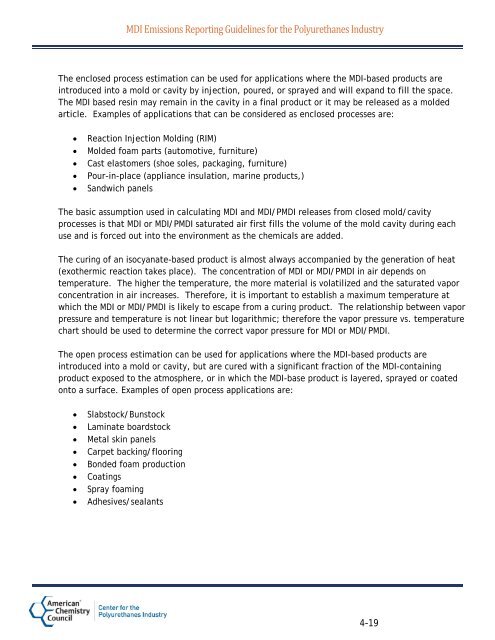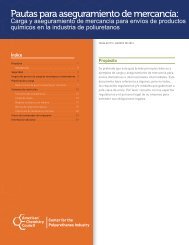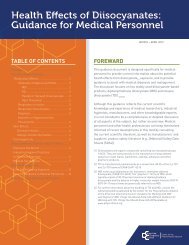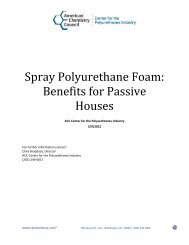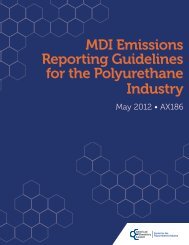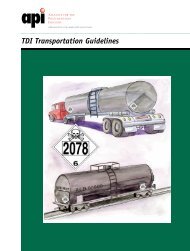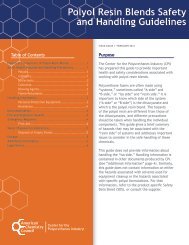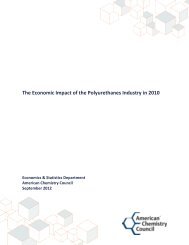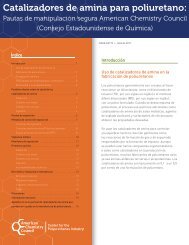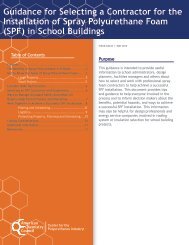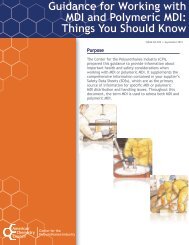MDI Emissions Reporting Guidelines for the ... - Polyurethanes
MDI Emissions Reporting Guidelines for the ... - Polyurethanes
MDI Emissions Reporting Guidelines for the ... - Polyurethanes
You also want an ePaper? Increase the reach of your titles
YUMPU automatically turns print PDFs into web optimized ePapers that Google loves.
<strong>MDI</strong> <strong>Emissions</strong> <strong>Reporting</strong> <strong>Guidelines</strong> <strong>for</strong> <strong>the</strong> <strong>Polyurethanes</strong> Industry<br />
The enclosed process estimation can be used <strong>for</strong> applications where <strong>the</strong> <strong>MDI</strong>-based products are<br />
introduced into a mold or cavity by injection, poured, or sprayed and will expand to fill <strong>the</strong> space.<br />
The <strong>MDI</strong> based resin may remain in <strong>the</strong> cavity in a final product or it may be released as a molded<br />
article. Examples of applications that can be considered as enclosed processes are:<br />
Reaction Injection Molding (RIM)<br />
Molded foam parts (automotive, furniture)<br />
Cast elastomers (shoe soles, packaging, furniture)<br />
Pour-in-place (appliance insulation, marine products,)<br />
Sandwich panels<br />
The basic assumption used in calculating <strong>MDI</strong> and <strong>MDI</strong>/P<strong>MDI</strong> releases from closed mold/cavity<br />
processes is that <strong>MDI</strong> or <strong>MDI</strong>/P<strong>MDI</strong> saturated air first fills <strong>the</strong> volume of <strong>the</strong> mold cavity during each<br />
use and is <strong>for</strong>ced out into <strong>the</strong> environment as <strong>the</strong> chemicals are added.<br />
The curing of an isocyanate-based product is almost always accompanied by <strong>the</strong> generation of heat<br />
(exo<strong>the</strong>rmic reaction takes place). The concentration of <strong>MDI</strong> or <strong>MDI</strong>/P<strong>MDI</strong> in air depends on<br />
temperature. The higher <strong>the</strong> temperature, <strong>the</strong> more material is volatilized and <strong>the</strong> saturated vapor<br />
concentration in air increases. There<strong>for</strong>e, it is important to establish a maximum temperature at<br />
which <strong>the</strong> <strong>MDI</strong> or <strong>MDI</strong>/P<strong>MDI</strong> is likely to escape from a curing product. The relationship between vapor<br />
pressure and temperature is not linear but logarithmic; <strong>the</strong>re<strong>for</strong>e <strong>the</strong> vapor pressure vs. temperature<br />
chart should be used to determine <strong>the</strong> correct vapor pressure <strong>for</strong> <strong>MDI</strong> or <strong>MDI</strong>/P<strong>MDI</strong>.<br />
The open process estimation can be used <strong>for</strong> applications where <strong>the</strong> <strong>MDI</strong>-based products are<br />
introduced into a mold or cavity, but are cured with a significant fraction of <strong>the</strong> <strong>MDI</strong>-containing<br />
product exposed to <strong>the</strong> atmosphere, or in which <strong>the</strong> <strong>MDI</strong>-base product is layered, sprayed or coated<br />
onto a surface. Examples of open process applications are:<br />
Slabstock/Bunstock<br />
Laminate boardstock<br />
Metal skin panels<br />
Carpet backing/flooring<br />
Bonded foam production<br />
Coatings<br />
Spray foaming<br />
Adhesives/sealants<br />
4-19


